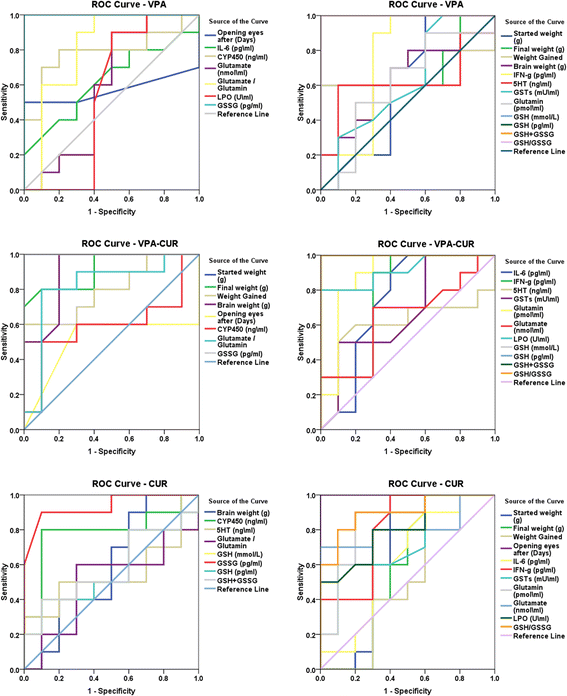Postnatal treatment using curcumin supplements to amend the damage in VPA-induced rodent models of autism
- PMID: 28486989
- PMCID: PMC5424332
- DOI: 10.1186/s12906-017-1763-7
Postnatal treatment using curcumin supplements to amend the damage in VPA-induced rodent models of autism
Abstract
Background: Valproic acid (VPA) is used as a first-line antiepileptic agent and is undergoing clinical trials for use as a treatment for many disorders. Mothers undergoing VPA treatment during early pregnancy reportedly show increased rates of autism among their offspring. The benefits of curcumin supplementation were investigated using an animal model of VPA-induced autism.
Methods: The study was performed using a rodent model of autism by exposing rat fetuses to valproic acid (VPA) on the 12.5th day of gestation. At 7 days from their birth, the animals were supplemented with a specific dose of curcumin. Forty neonatal male Western Albino rats were divided into four groups. Rats in group I received only phosphate-buffered saline, rats in group II were the prenatal VPA exposure newborns, rats in group III underwent prenatal VPA exposure supplemented with postnatal curcumin, and rats in group IV were given only postnatal curcumin supplements.
Results: VPA rats exhibited delayed maturation and lower body and brain weights with numerous signs of brain toxicity, such as depletion of IFN-γ, serotonin, glutamine, reduced glutathione, glutathione S-transferase, lipid peroxidase with an increase in CYP450, IL-6, glutamate, and oxidized glutathione. A curcumin supplement moderately corrected these dysfunctions and was especially noticeable in improving delayed maturation and abnormal weight.
Conclusions: Curcumin plays a significant therapeutic role in attenuating brain damage that has been induced by prenatal VPA exposure in rats; however, its therapeutic role as a dietary supplement still must be certified for use in humans.
Keywords: Autism; Curcumin; Cytokines; Glutathione; Neurodevelopment valproic acid; Serotonin.
Figures
References
-
- Ergaz Z, Weinstein-Fudim L, Ornoy A. Genetic and non-genetic animal models for autism spectrum disorders (ASD) Reprod. Toxicology. 2016;64:116–140. - PubMed
-
- Kazlauskas N, Campolongo M, Lucchina L, Zappala C, Depino AM. Postnatal behavioral and inflammatory alterations in female pupsprenatally exposed to valproic acid. Psychoneuroendocrinology. 2016;72:11–21. - PubMed
-
- Kim JW, Seung H, Kim KC, Gonzales EL, Oh HA, Yang SM, Ko MJ, Han SH, Banerjee S, Shin CY. Agmatine rescues autistic behaviors in the valproic acid-induced animal model of autism. Neuropharmacology. 2017;113(Pt A):71–81. - PubMed
MeSH terms
Substances
LinkOut - more resources
Full Text Sources
Other Literature Sources
Medical




